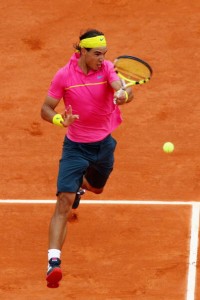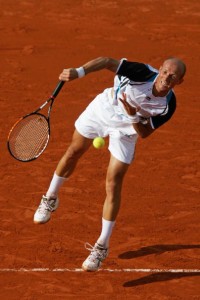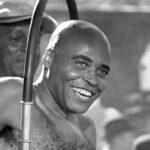Clay Season Could Shuffle ATP Rankings

For the first time, Roger Federer enters the clay court season as the defending French Open Champion.
How do you measure the worth of a man—or, more specifically, the relative strength of a professional tennis player?
You do it by looking at their ranking points. It is simple enough.
The player with the most points earned by participating in tournaments, some mandatory and some voluntary, lets you know where this player stands compared to his peers.
Right now, the current No. 1 player in the world has 10,765 points, accumulated over the past year. But what does that ultimately mean?
Between the top-ranked player in the world, Roger Federer, and the No. 6 ranked player, Nikolay Davydenko, there are 5,430 ATP ranking points as of April 5. On Feb. 1, 2010, the spread between those same two players was over 6,000 points.
While the difference between No. 1 and No. 2 continues to hover at 3,000 points, the distance between the rest of the field in the top six shrunk dramatically following the conclusion of the Sony Ericsson Open in Miami. The fallout was a true rankings dip for all the top-seeded players not named Rafael Nadal.
Specifically, the difference between Nadal, now ranked at No. 3, and Novak Djokovic, at No. 2, is just 650 points. The distance between Nadal and Andy Murray, now seeded No. 4, is 1,135 points, while the space between Murray and Juan Martin del Potro, seeded No. 5, is a mere 110. Davydenko sits only 510 points behind Murray and 400 points behind del Potro. Andy Roddick, ranked No. 7, remains 555 points behind Davydenko.
This is a new world order in men’s tennis, with far less space to breathe.
If you go back five years and look at the rankings race, you’ll note that in 2005, Federer sat pretty much alone at the top, some 3,000 points ahead of Roddick, and this was long before the tour doubled the points to account for the new emphasis on winning Grand Slams.
In 2006, Federer and Nadal as No. 1 and No. 2 sat on top of the rankings as the top two—then the rest of the field with Andy Roddick back at the No. 3 spot. The top two reigned again in 2007, with Davydenko a distant third.
In January of 2008, the top two became the top three, with Djokovic edging close to the No. 2 spot while Davydenko remained a distant fourth. But in 2009, after the points doubled, the No. 4 position became inhabited by Murray—the top three became the top four in the media.
While the top four players have had periods of infringement in 2008-2009, when they bumped each other off a perch and traded positions, there was a distinct line of demarcation between the top four and the rest of the top 10.
But with del Potro’s rise after winning the 2009 U.S. Open, position No. 5 moved into the upper tier edging closer to the No. 4 ranked player.
As so many of the top players close the gap on the player in front of them, it simply means parity is arriving once again in men’s professional tennis. The last two Masters events verify that conclusion.
That definitely makes the upcoming clay-court matches much more exciting and the whole tour more appealing, at least for the top-tiered tournaments.
Everyone is looking forward to Nadal and his return to reign as the Clay Court King. The point is he’d better do well; otherwise he will begin sinking again, because he has a pot full of points to defend in order to stay level.
If you look at the potential between now and the French Open, you see that there could very well be a huge shakeup among the top-ranked players—at least those ranked below Federer on the ATP ranking ladder.
Much of the potential shift will become evident when you examine the number of points the top six players must defend between now and the French Open.
Roger Federer: Points to Defend from 2009: 3,450 total points.
ATP WTM 1000 Monte Carlo [R16-90 pts]; ATP WTM 1000 Rome [Semifinals – 360 pts]; ATP WTM 1000 Madrid [Winner 1,000 pts]; GS Roland Garros [Winner 2,000 pts].
Federer is fairly safe now as he sits over 3,000 points ahead of Djokovic. The bulk of his points come from wins at two big tournaments, Madrid and the French Open at Stade Roland Garros. Federer has elected to play again at Estoril and will not be competing in Monte Carlo in 2010.
That means he could advance his points, since he only gives up 90 from Monte Carlo and could pick up 250 by taking the title in Estoril, which he won in 2008. If he does better than the semifinals in Rome and does well at both Madrid and the French Open, we can expect Federer to retain his No. 1 ranking.
It also means the Swiss will surpass Pete Sampras’ record of 286 weeks on June 14 for the most weeks at No. 1.
Rafael Nadal: Points to Defend from 2009: 3,280 total points.
ATP WTM 1000 Monte Carlo [Winner – 1,000 pts]; Barcelona [Winner – 500 pts]; ATP WTM 1000 Rome [Winner – 1000 pts]; ATP WTM 1000 Madrid [Finalist 600 pts]; GS Roland Garros [R 16 180 pts.].

Rafael Nadal is known for his prominence on clay.
Nadal is the defending champion at Monte Carlo, Barcelona, and Rome, as well as a finalist in Madrid. He is playing each of these tournaments, and there is no expectation that he will not do well. In order to maintain his current rankings spot, he must play his level best and wait for others to falter, especially Djokovic, who sits ahead of him by 650 points.
The chance for him to make up significant ground does not come until the French Open, where he is only defending 180 points after being summarily dismissed by Robin Soderling last year in the fourth round.
But it also means not going down to defeat early in any of the lead-up tournaments to the red clay at Stade Roland Garros. It stands to reason to expect Nadal to take over the No. 2 spot before the French Open—but only because Djokovic will falter.
Novak Djokovic: Points to Defend from 2009: 1,900 total points.
ATP WTM 1000 Monte Carlo [Finalist – 600 pts]; Belgrade [Winner – 250 pts]; ATP WTM 1000 Rome [Finalist – 600 pts]; ATP WTM 1000 Madrid [Semifinalist 360 pts]; GS Roland Garros [R 32 90 pts.].
Djokovic has many points he could lose early on as a finalist in both Monte Carlo and Rome as well as the winner in the Serbian tournament in Belgrade in 2009. The Serb has certainly been off his game of late, and one wonders if he will be ready for the rigors of clay. Only 650 points ahead of Nadal, losing early in these opening clay-court events could cost Djokovic the No. 2 ranking.
The Serb has an opportunity to make up ground at the French Open, where he went out early in the Round of 32, securing only 90 points. Perhaps the challenge to hang onto the No. 2 spot will spur Djokovic into action. But nothing in his on court demeanor suggests he is aggressively seeking a remedy to his recent spate of premature losses.
Andy Murray: Points to Defend from 2009: 910 total points.
ATP WTM 1000 Monte Carlo [Semifinalist – 360 pts]; ATP WTM 1000 Rome [R32 – 10 pts]; ATP WTM 1000 Madrid [Quarterfinalist 180 pts]; GS Roland Garros [Quarterfinalist 360 pts.].
Andy Murray, now reunited with his girlfriend, has a solid chance to gain some ground on the players ranked ahead of him at the start of the clay season. He has few points to defend and therefore, a golden opportunity to overtake the No. 3 player, 1,135 points ahead of him at the moment.
Finally he accepted a wild card into the event at Monte Carlo, where he finished as a semifinalist a year ago. His entrance into the tournament this year means the Scot is trying to bolster his falling rankings. Improving upon last year’s finishes could do Murray a world of good and propel him back to his winning ways.
The finish line is clearly marked for Murray, but you have to wonder at his commitment at this point. The time is now, Mr. Murray.
Juan Martin del Potro: Points to Defend from 2009: 1,270 total points.
ATP WTM 1000 Monte Carlo [R32 – 10 pts]; ATP WTM 1000 Rome [Quarterfinalist – 180 pts]; ATP WTM 1000 Madrid [Semifinalist 360 pts]; GS Roland Garros [Semifinalist 720 pts.].
Del Potro is the player most would anticipate moving up fast during the current clay season. But at this point, it is hard to predict how completely recovered the Argentine is from his lingering wrist injury. This ailment has kept del Potro off the court for some time and, even when he competed, the injury evidently affected his ability to play the game at his best level.
Del Potro is only 110 points behind Murray, and it would take little to overtake the Scot, especially because del Potro has few points to defend until his semifinal finish at the French Open.
Scheduled to compete at Monte Carlo, it will be crucial for the Argentine to show himself fully fit and ready to compete. If that is the case, we can expect del Potro to continue his climb up the rankings ladder.
Nikolay Davydenko: Points to Defend from 2009: 910 total points.
ATP WTM 1000 Monte Carlo [Quarterfinalist – 180 pts]; Barcelona [Semifinalist – 180 pts]; ATP WTM 1000 Rome [R32 – 10 pts]; Estoril [Semifinalist – 90 pts]; ATP WTM 1000 Madrid [R16 90 pts]; GS Roland Garros [Quarterfinalist 360 pts.].

Nikolay Davydenko is always a dangerous player, but a broken wrist could derail his spring.
With a modest amount of points to defend, Davydenko is always a dangerous player on clay with his speed and stamina in full force. But it is hard to imagine that the Russian will be able to play with a broken wrist. It has been reported that Davydenko may be out for as long as three months. Without playing, Davydenko cannot advance—he can only fall further back—unless he can protect his ranking because of his injury.
Of the two sitting just behind Davydenko, Roddick and Soderling, you have to give the edge to the Swede Soderling, who has shown how well he can play on the red clay.
While some clay-court events are currently under way, the real action does not begin until next week.
Some of the questions about the top players’ mental edge will be answered as they head to Monte Carlo, where Nadal has reigned supreme for five straight years.
Do we expect him to win No. 6? Most do, and with good reason. A loss at this event for Nadal would signal a real shift at the top.















